Business Law Assignment: Misrepresentation and Negligence
VerifiedAdded on 2023/06/11
|9
|2325
|477
Homework Assignment
AI Summary
This document presents a business law assignment that addresses two distinct legal issues: misrepresentation in the context of a restaurant purchase and negligence related to a contaminated beverage. The first part of the assignment analyzes a scenario where a restaurant owner, Jessica, is accused of misrepresentation to Angela regarding the restaurant's profits. It examines the elements of misrepresentation, referencing key cases such as Kalabakas v Chubb Insurance, Bisset v Wilkinson, and Smith v Land & House Property Corp, to determine Jessica's liability. The second part focuses on a negligence claim against a cola manufacturer. It explores the concept of duty of care, as established in Donoghue v Stevenson, and its application to the scenario where a consumer, Sandra Smith's husband, suffered illness after consuming the product. The analysis considers breach of duty, causation, and remoteness of damage, citing relevant cases like Taylor v Haileybury and The Uniting Church v Takacs to establish the manufacturer's potential liability. The assignment concludes with a determination of the legal outcomes for each scenario.
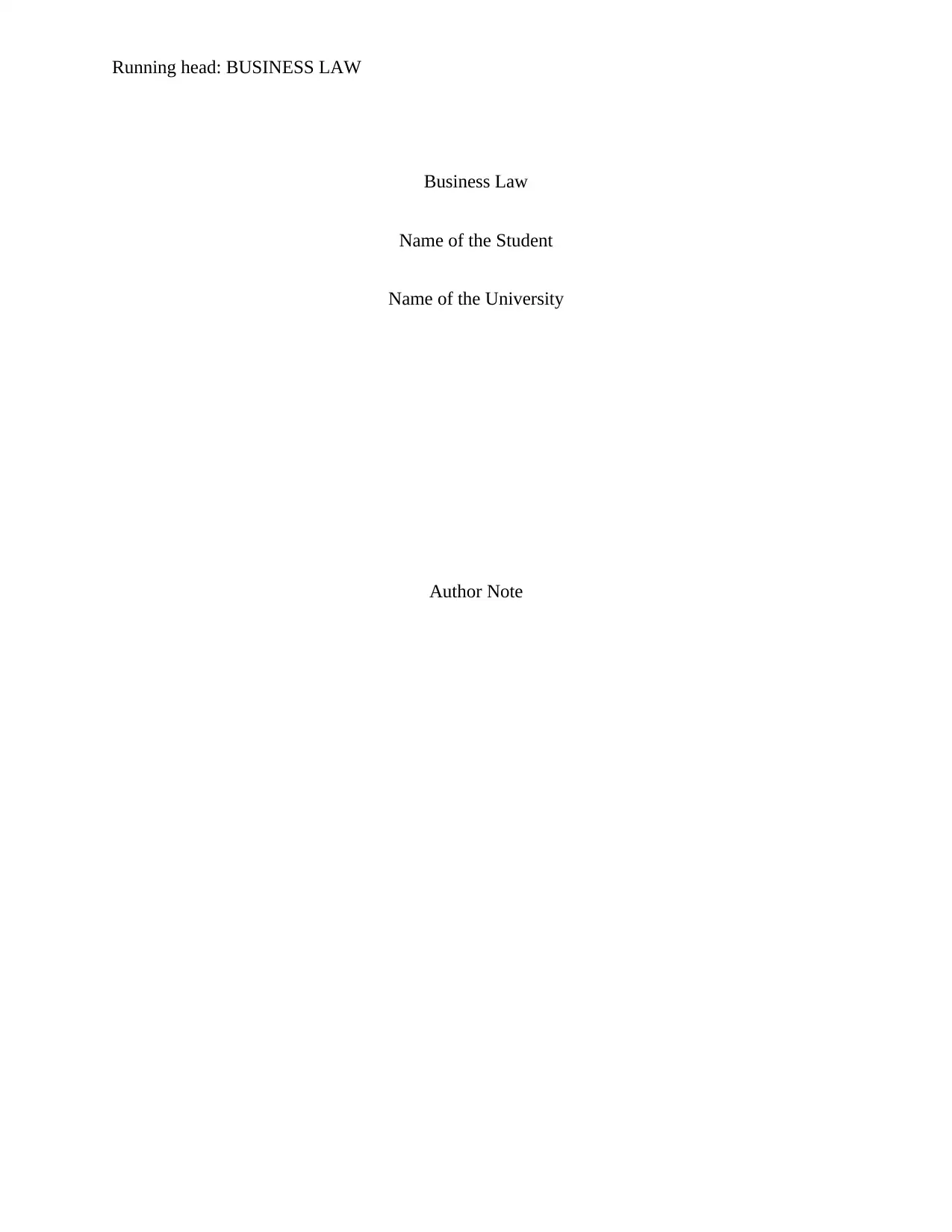
Running head: BUSINESS LAW
Business Law
Name of the Student
Name of the University
Author Note
Business Law
Name of the Student
Name of the University
Author Note
Paraphrase This Document
Need a fresh take? Get an instant paraphrase of this document with our AI Paraphraser
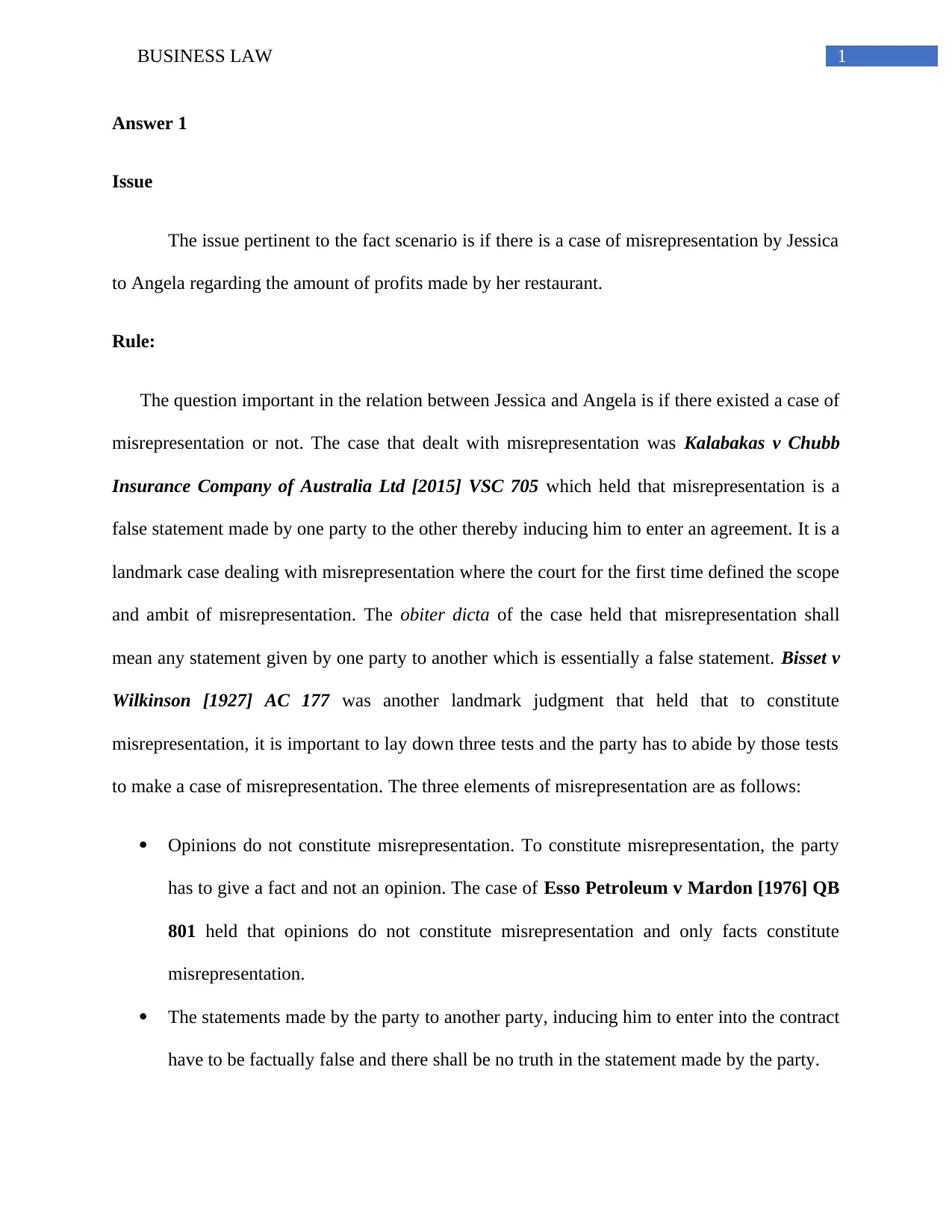
1BUSINESS LAW
Answer 1
Issue
The issue pertinent to the fact scenario is if there is a case of misrepresentation by Jessica
to Angela regarding the amount of profits made by her restaurant.
Rule:
The question important in the relation between Jessica and Angela is if there existed a case of
misrepresentation or not. The case that dealt with misrepresentation was Kalabakas v Chubb
Insurance Company of Australia Ltd [2015] VSC 705 which held that misrepresentation is a
false statement made by one party to the other thereby inducing him to enter an agreement. It is a
landmark case dealing with misrepresentation where the court for the first time defined the scope
and ambit of misrepresentation. The obiter dicta of the case held that misrepresentation shall
mean any statement given by one party to another which is essentially a false statement. Bisset v
Wilkinson [1927] AC 177 was another landmark judgment that held that to constitute
misrepresentation, it is important to lay down three tests and the party has to abide by those tests
to make a case of misrepresentation. The three elements of misrepresentation are as follows:
Opinions do not constitute misrepresentation. To constitute misrepresentation, the party
has to give a fact and not an opinion. The case of Esso Petroleum v Mardon [1976] QB
801 held that opinions do not constitute misrepresentation and only facts constitute
misrepresentation.
The statements made by the party to another party, inducing him to enter into the contract
have to be factually false and there shall be no truth in the statement made by the party.
Answer 1
Issue
The issue pertinent to the fact scenario is if there is a case of misrepresentation by Jessica
to Angela regarding the amount of profits made by her restaurant.
Rule:
The question important in the relation between Jessica and Angela is if there existed a case of
misrepresentation or not. The case that dealt with misrepresentation was Kalabakas v Chubb
Insurance Company of Australia Ltd [2015] VSC 705 which held that misrepresentation is a
false statement made by one party to the other thereby inducing him to enter an agreement. It is a
landmark case dealing with misrepresentation where the court for the first time defined the scope
and ambit of misrepresentation. The obiter dicta of the case held that misrepresentation shall
mean any statement given by one party to another which is essentially a false statement. Bisset v
Wilkinson [1927] AC 177 was another landmark judgment that held that to constitute
misrepresentation, it is important to lay down three tests and the party has to abide by those tests
to make a case of misrepresentation. The three elements of misrepresentation are as follows:
Opinions do not constitute misrepresentation. To constitute misrepresentation, the party
has to give a fact and not an opinion. The case of Esso Petroleum v Mardon [1976] QB
801 held that opinions do not constitute misrepresentation and only facts constitute
misrepresentation.
The statements made by the party to another party, inducing him to enter into the contract
have to be factually false and there shall be no truth in the statement made by the party.
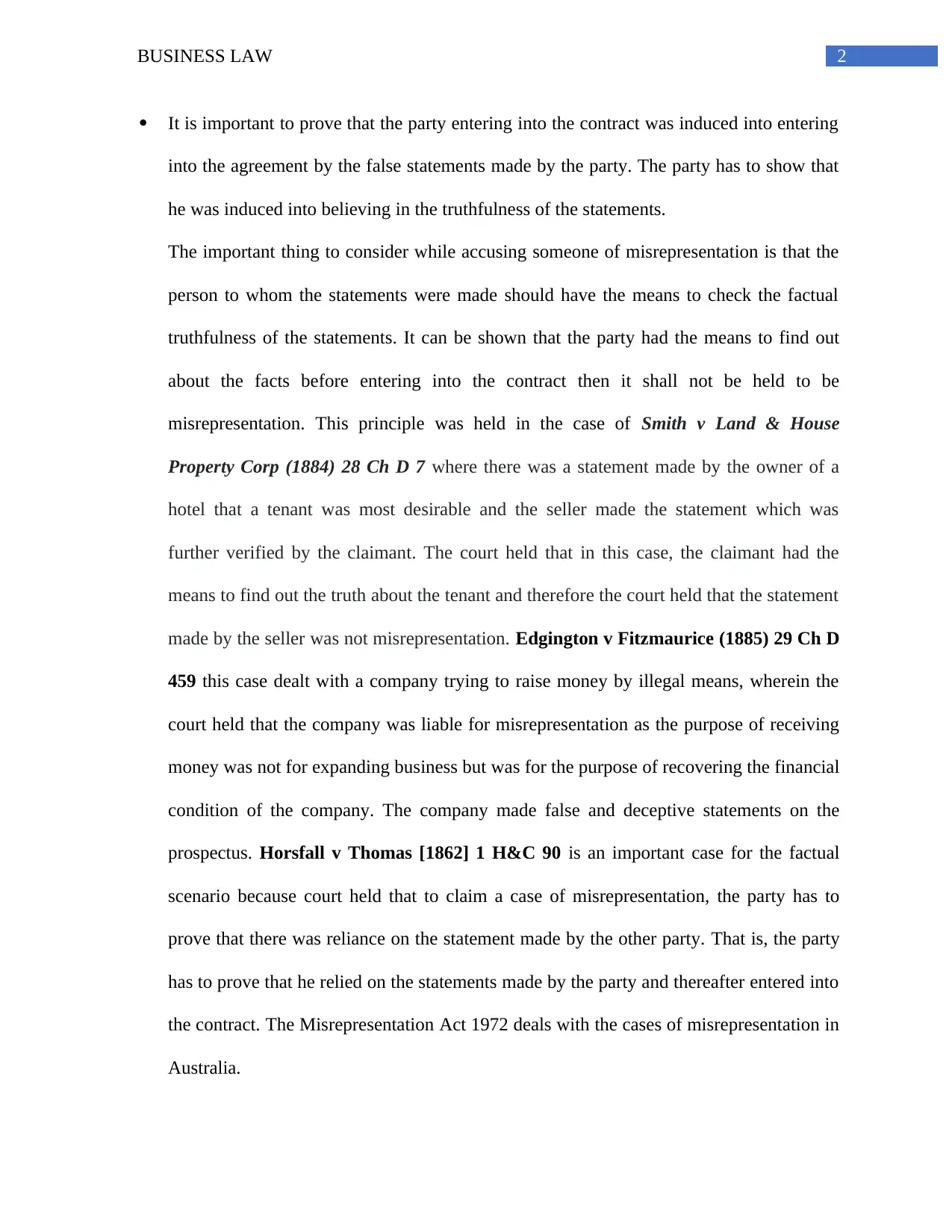
2BUSINESS LAW
It is important to prove that the party entering into the contract was induced into entering
into the agreement by the false statements made by the party. The party has to show that
he was induced into believing in the truthfulness of the statements.
The important thing to consider while accusing someone of misrepresentation is that the
person to whom the statements were made should have the means to check the factual
truthfulness of the statements. It can be shown that the party had the means to find out
about the facts before entering into the contract then it shall not be held to be
misrepresentation. This principle was held in the case of Smith v Land & House
Property Corp (1884) 28 Ch D 7 where there was a statement made by the owner of a
hotel that a tenant was most desirable and the seller made the statement which was
further verified by the claimant. The court held that in this case, the claimant had the
means to find out the truth about the tenant and therefore the court held that the statement
made by the seller was not misrepresentation. Edgington v Fitzmaurice (1885) 29 Ch D
459 this case dealt with a company trying to raise money by illegal means, wherein the
court held that the company was liable for misrepresentation as the purpose of receiving
money was not for expanding business but was for the purpose of recovering the financial
condition of the company. The company made false and deceptive statements on the
prospectus. Horsfall v Thomas [1862] 1 H&C 90 is an important case for the factual
scenario because court held that to claim a case of misrepresentation, the party has to
prove that there was reliance on the statement made by the other party. That is, the party
has to prove that he relied on the statements made by the party and thereafter entered into
the contract. The Misrepresentation Act 1972 deals with the cases of misrepresentation in
Australia.
It is important to prove that the party entering into the contract was induced into entering
into the agreement by the false statements made by the party. The party has to show that
he was induced into believing in the truthfulness of the statements.
The important thing to consider while accusing someone of misrepresentation is that the
person to whom the statements were made should have the means to check the factual
truthfulness of the statements. It can be shown that the party had the means to find out
about the facts before entering into the contract then it shall not be held to be
misrepresentation. This principle was held in the case of Smith v Land & House
Property Corp (1884) 28 Ch D 7 where there was a statement made by the owner of a
hotel that a tenant was most desirable and the seller made the statement which was
further verified by the claimant. The court held that in this case, the claimant had the
means to find out the truth about the tenant and therefore the court held that the statement
made by the seller was not misrepresentation. Edgington v Fitzmaurice (1885) 29 Ch D
459 this case dealt with a company trying to raise money by illegal means, wherein the
court held that the company was liable for misrepresentation as the purpose of receiving
money was not for expanding business but was for the purpose of recovering the financial
condition of the company. The company made false and deceptive statements on the
prospectus. Horsfall v Thomas [1862] 1 H&C 90 is an important case for the factual
scenario because court held that to claim a case of misrepresentation, the party has to
prove that there was reliance on the statement made by the other party. That is, the party
has to prove that he relied on the statements made by the party and thereafter entered into
the contract. The Misrepresentation Act 1972 deals with the cases of misrepresentation in
Australia.
⊘ This is a preview!⊘
Do you want full access?
Subscribe today to unlock all pages.

Trusted by 1+ million students worldwide
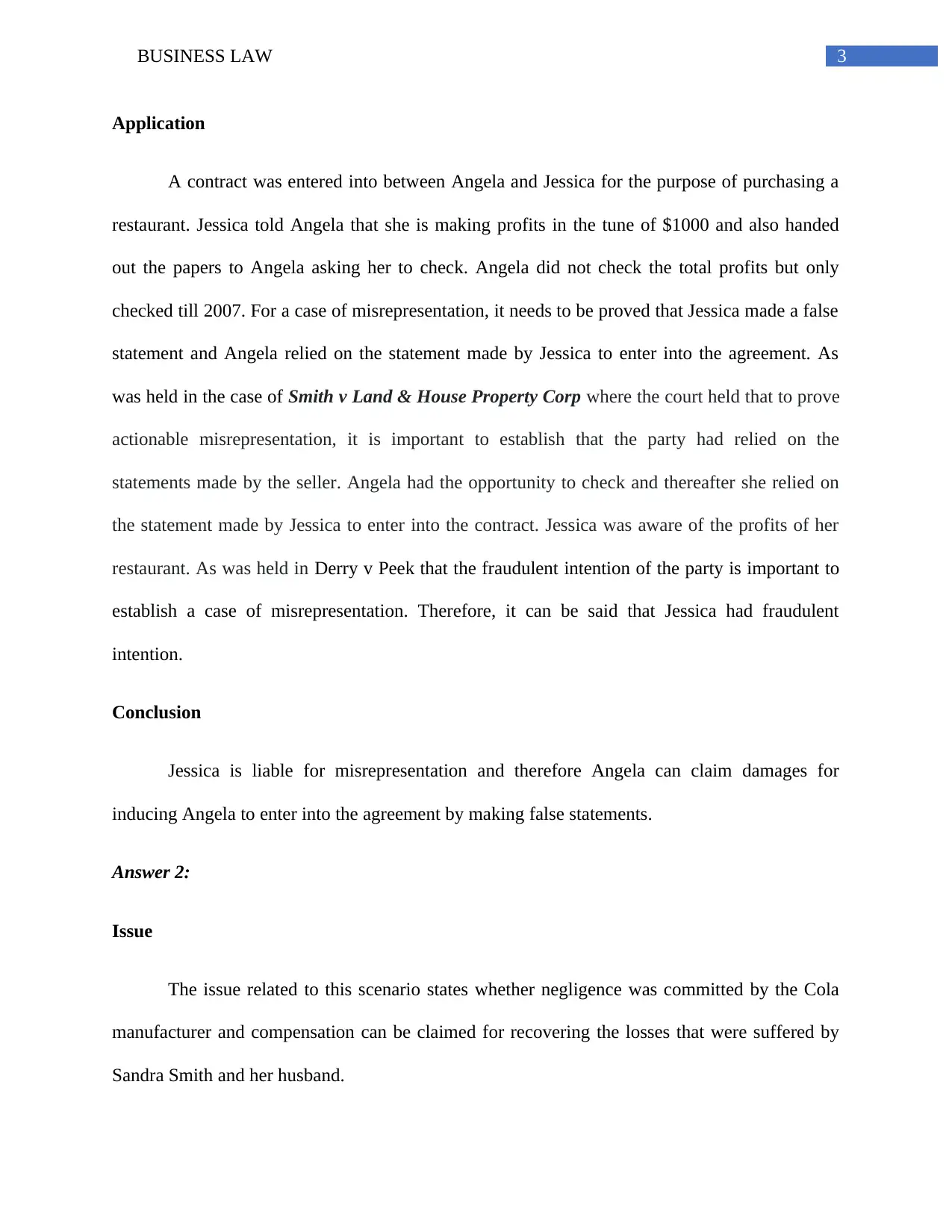
3BUSINESS LAW
Application
A contract was entered into between Angela and Jessica for the purpose of purchasing a
restaurant. Jessica told Angela that she is making profits in the tune of $1000 and also handed
out the papers to Angela asking her to check. Angela did not check the total profits but only
checked till 2007. For a case of misrepresentation, it needs to be proved that Jessica made a false
statement and Angela relied on the statement made by Jessica to enter into the agreement. As
was held in the case of Smith v Land & House Property Corp where the court held that to prove
actionable misrepresentation, it is important to establish that the party had relied on the
statements made by the seller. Angela had the opportunity to check and thereafter she relied on
the statement made by Jessica to enter into the contract. Jessica was aware of the profits of her
restaurant. As was held in Derry v Peek that the fraudulent intention of the party is important to
establish a case of misrepresentation. Therefore, it can be said that Jessica had fraudulent
intention.
Conclusion
Jessica is liable for misrepresentation and therefore Angela can claim damages for
inducing Angela to enter into the agreement by making false statements.
Answer 2:
Issue
The issue related to this scenario states whether negligence was committed by the Cola
manufacturer and compensation can be claimed for recovering the losses that were suffered by
Sandra Smith and her husband.
Application
A contract was entered into between Angela and Jessica for the purpose of purchasing a
restaurant. Jessica told Angela that she is making profits in the tune of $1000 and also handed
out the papers to Angela asking her to check. Angela did not check the total profits but only
checked till 2007. For a case of misrepresentation, it needs to be proved that Jessica made a false
statement and Angela relied on the statement made by Jessica to enter into the agreement. As
was held in the case of Smith v Land & House Property Corp where the court held that to prove
actionable misrepresentation, it is important to establish that the party had relied on the
statements made by the seller. Angela had the opportunity to check and thereafter she relied on
the statement made by Jessica to enter into the contract. Jessica was aware of the profits of her
restaurant. As was held in Derry v Peek that the fraudulent intention of the party is important to
establish a case of misrepresentation. Therefore, it can be said that Jessica had fraudulent
intention.
Conclusion
Jessica is liable for misrepresentation and therefore Angela can claim damages for
inducing Angela to enter into the agreement by making false statements.
Answer 2:
Issue
The issue related to this scenario states whether negligence was committed by the Cola
manufacturer and compensation can be claimed for recovering the losses that were suffered by
Sandra Smith and her husband.
Paraphrase This Document
Need a fresh take? Get an instant paraphrase of this document with our AI Paraphraser
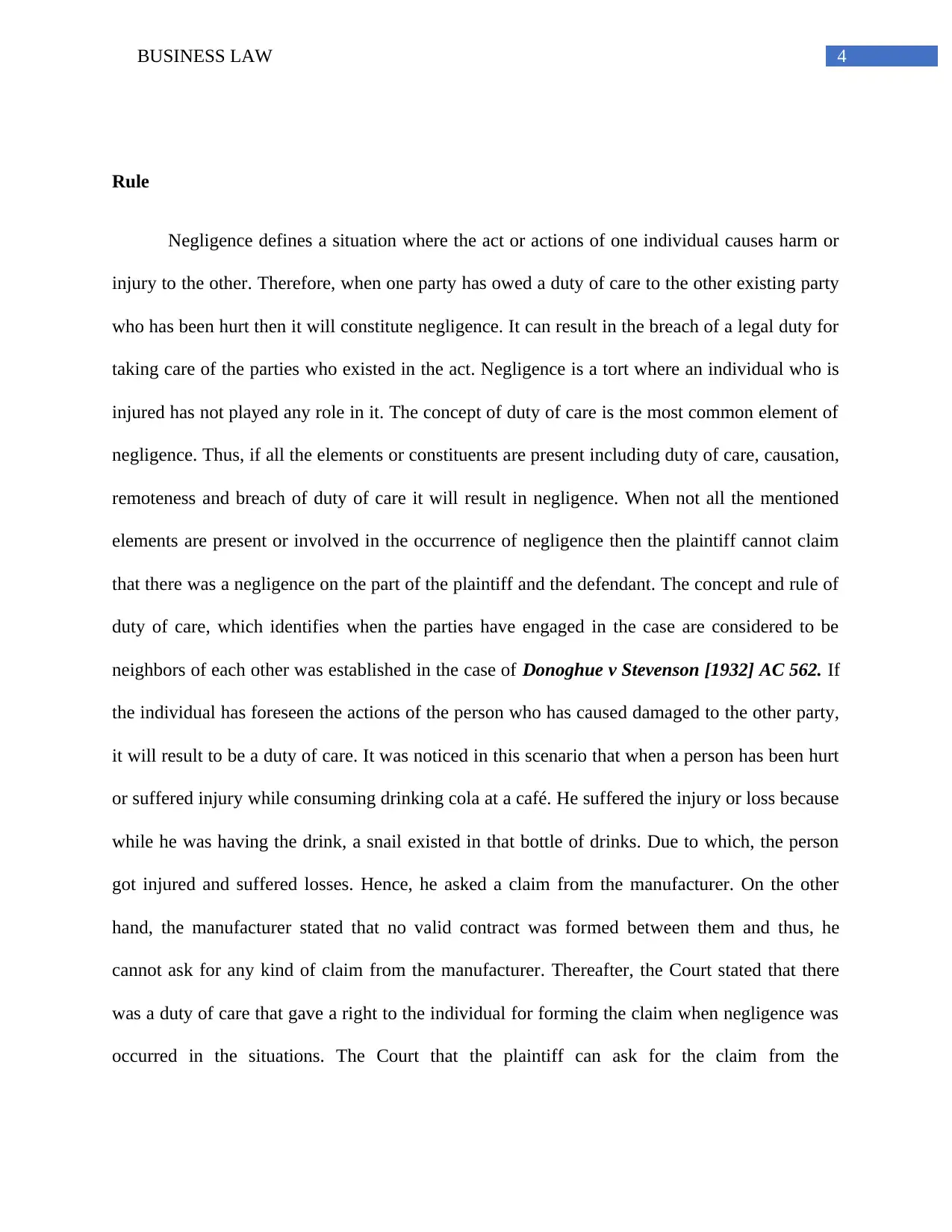
4BUSINESS LAW
Rule
Negligence defines a situation where the act or actions of one individual causes harm or
injury to the other. Therefore, when one party has owed a duty of care to the other existing party
who has been hurt then it will constitute negligence. It can result in the breach of a legal duty for
taking care of the parties who existed in the act. Negligence is a tort where an individual who is
injured has not played any role in it. The concept of duty of care is the most common element of
negligence. Thus, if all the elements or constituents are present including duty of care, causation,
remoteness and breach of duty of care it will result in negligence. When not all the mentioned
elements are present or involved in the occurrence of negligence then the plaintiff cannot claim
that there was a negligence on the part of the plaintiff and the defendant. The concept and rule of
duty of care, which identifies when the parties have engaged in the case are considered to be
neighbors of each other was established in the case of Donoghue v Stevenson [1932] AC 562. If
the individual has foreseen the actions of the person who has caused damaged to the other party,
it will result to be a duty of care. It was noticed in this scenario that when a person has been hurt
or suffered injury while consuming drinking cola at a café. He suffered the injury or loss because
while he was having the drink, a snail existed in that bottle of drinks. Due to which, the person
got injured and suffered losses. Hence, he asked a claim from the manufacturer. On the other
hand, the manufacturer stated that no valid contract was formed between them and thus, he
cannot ask for any kind of claim from the manufacturer. Thereafter, the Court stated that there
was a duty of care that gave a right to the individual for forming the claim when negligence was
occurred in the situations. The Court that the plaintiff can ask for the claim from the
Rule
Negligence defines a situation where the act or actions of one individual causes harm or
injury to the other. Therefore, when one party has owed a duty of care to the other existing party
who has been hurt then it will constitute negligence. It can result in the breach of a legal duty for
taking care of the parties who existed in the act. Negligence is a tort where an individual who is
injured has not played any role in it. The concept of duty of care is the most common element of
negligence. Thus, if all the elements or constituents are present including duty of care, causation,
remoteness and breach of duty of care it will result in negligence. When not all the mentioned
elements are present or involved in the occurrence of negligence then the plaintiff cannot claim
that there was a negligence on the part of the plaintiff and the defendant. The concept and rule of
duty of care, which identifies when the parties have engaged in the case are considered to be
neighbors of each other was established in the case of Donoghue v Stevenson [1932] AC 562. If
the individual has foreseen the actions of the person who has caused damaged to the other party,
it will result to be a duty of care. It was noticed in this scenario that when a person has been hurt
or suffered injury while consuming drinking cola at a café. He suffered the injury or loss because
while he was having the drink, a snail existed in that bottle of drinks. Due to which, the person
got injured and suffered losses. Hence, he asked a claim from the manufacturer. On the other
hand, the manufacturer stated that no valid contract was formed between them and thus, he
cannot ask for any kind of claim from the manufacturer. Thereafter, the Court stated that there
was a duty of care that gave a right to the individual for forming the claim when negligence was
occurred in the situations. The Court that the plaintiff can ask for the claim from the
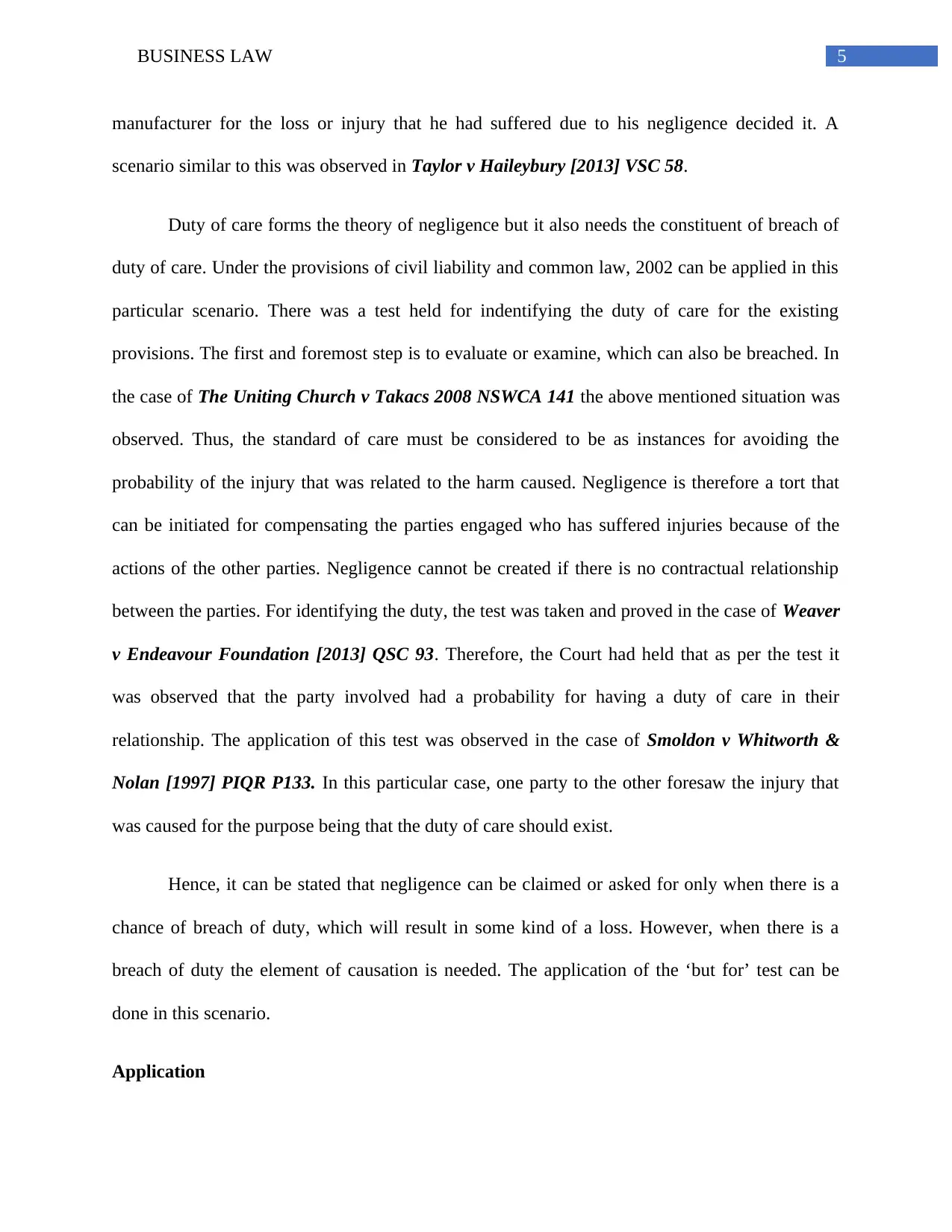
5BUSINESS LAW
manufacturer for the loss or injury that he had suffered due to his negligence decided it. A
scenario similar to this was observed in Taylor v Haileybury [2013] VSC 58.
Duty of care forms the theory of negligence but it also needs the constituent of breach of
duty of care. Under the provisions of civil liability and common law, 2002 can be applied in this
particular scenario. There was a test held for indentifying the duty of care for the existing
provisions. The first and foremost step is to evaluate or examine, which can also be breached. In
the case of The Uniting Church v Takacs 2008 NSWCA 141 the above mentioned situation was
observed. Thus, the standard of care must be considered to be as instances for avoiding the
probability of the injury that was related to the harm caused. Negligence is therefore a tort that
can be initiated for compensating the parties engaged who has suffered injuries because of the
actions of the other parties. Negligence cannot be created if there is no contractual relationship
between the parties. For identifying the duty, the test was taken and proved in the case of Weaver
v Endeavour Foundation [2013] QSC 93. Therefore, the Court had held that as per the test it
was observed that the party involved had a probability for having a duty of care in their
relationship. The application of this test was observed in the case of Smoldon v Whitworth &
Nolan [1997] PIQR P133. In this particular case, one party to the other foresaw the injury that
was caused for the purpose being that the duty of care should exist.
Hence, it can be stated that negligence can be claimed or asked for only when there is a
chance of breach of duty, which will result in some kind of a loss. However, when there is a
breach of duty the element of causation is needed. The application of the ‘but for’ test can be
done in this scenario.
Application
manufacturer for the loss or injury that he had suffered due to his negligence decided it. A
scenario similar to this was observed in Taylor v Haileybury [2013] VSC 58.
Duty of care forms the theory of negligence but it also needs the constituent of breach of
duty of care. Under the provisions of civil liability and common law, 2002 can be applied in this
particular scenario. There was a test held for indentifying the duty of care for the existing
provisions. The first and foremost step is to evaluate or examine, which can also be breached. In
the case of The Uniting Church v Takacs 2008 NSWCA 141 the above mentioned situation was
observed. Thus, the standard of care must be considered to be as instances for avoiding the
probability of the injury that was related to the harm caused. Negligence is therefore a tort that
can be initiated for compensating the parties engaged who has suffered injuries because of the
actions of the other parties. Negligence cannot be created if there is no contractual relationship
between the parties. For identifying the duty, the test was taken and proved in the case of Weaver
v Endeavour Foundation [2013] QSC 93. Therefore, the Court had held that as per the test it
was observed that the party involved had a probability for having a duty of care in their
relationship. The application of this test was observed in the case of Smoldon v Whitworth &
Nolan [1997] PIQR P133. In this particular case, one party to the other foresaw the injury that
was caused for the purpose being that the duty of care should exist.
Hence, it can be stated that negligence can be claimed or asked for only when there is a
chance of breach of duty, which will result in some kind of a loss. However, when there is a
breach of duty the element of causation is needed. The application of the ‘but for’ test can be
done in this scenario.
Application
⊘ This is a preview!⊘
Do you want full access?
Subscribe today to unlock all pages.

Trusted by 1+ million students worldwide
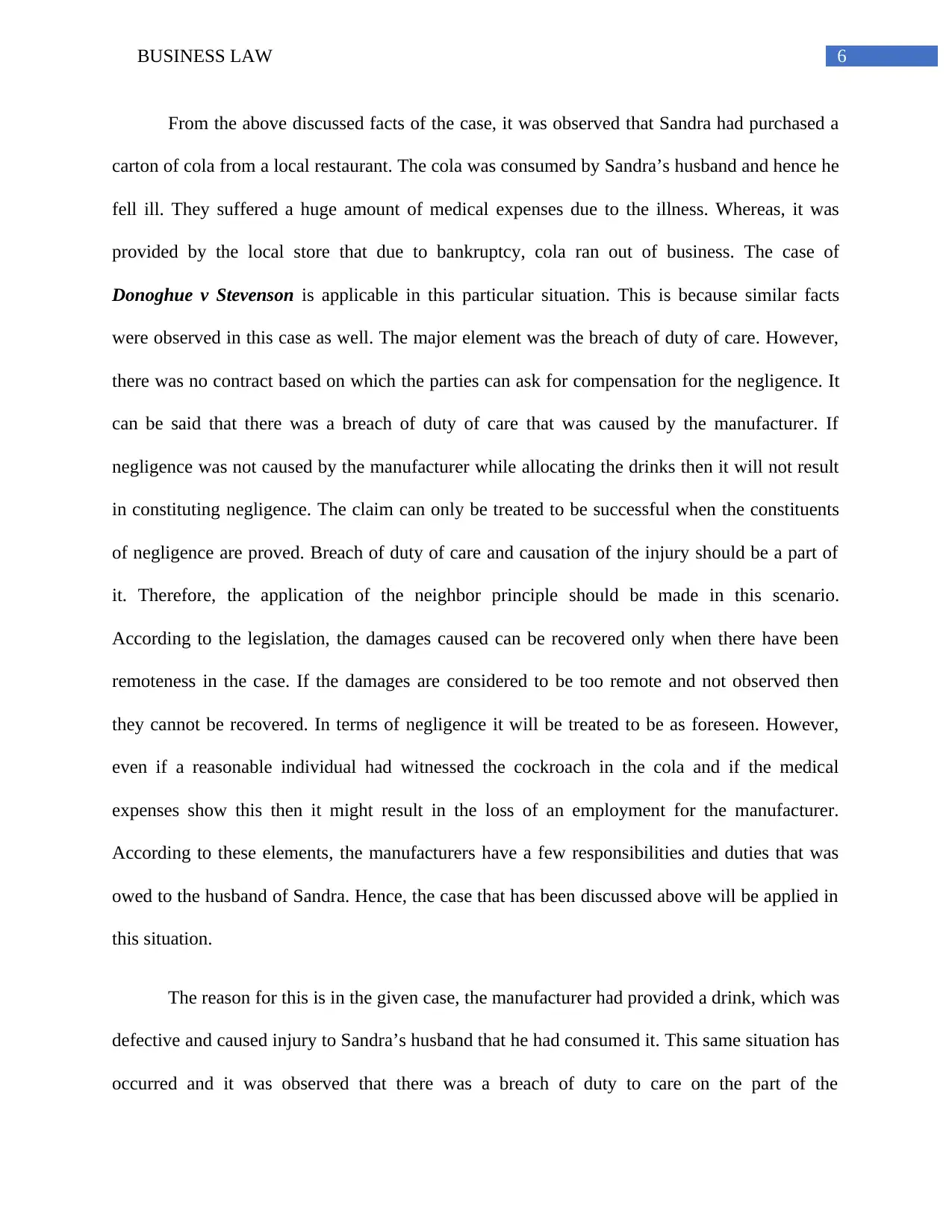
6BUSINESS LAW
From the above discussed facts of the case, it was observed that Sandra had purchased a
carton of cola from a local restaurant. The cola was consumed by Sandra’s husband and hence he
fell ill. They suffered a huge amount of medical expenses due to the illness. Whereas, it was
provided by the local store that due to bankruptcy, cola ran out of business. The case of
Donoghue v Stevenson is applicable in this particular situation. This is because similar facts
were observed in this case as well. The major element was the breach of duty of care. However,
there was no contract based on which the parties can ask for compensation for the negligence. It
can be said that there was a breach of duty of care that was caused by the manufacturer. If
negligence was not caused by the manufacturer while allocating the drinks then it will not result
in constituting negligence. The claim can only be treated to be successful when the constituents
of negligence are proved. Breach of duty of care and causation of the injury should be a part of
it. Therefore, the application of the neighbor principle should be made in this scenario.
According to the legislation, the damages caused can be recovered only when there have been
remoteness in the case. If the damages are considered to be too remote and not observed then
they cannot be recovered. In terms of negligence it will be treated to be as foreseen. However,
even if a reasonable individual had witnessed the cockroach in the cola and if the medical
expenses show this then it might result in the loss of an employment for the manufacturer.
According to these elements, the manufacturers have a few responsibilities and duties that was
owed to the husband of Sandra. Hence, the case that has been discussed above will be applied in
this situation.
The reason for this is in the given case, the manufacturer had provided a drink, which was
defective and caused injury to Sandra’s husband that he had consumed it. This same situation has
occurred and it was observed that there was a breach of duty to care on the part of the
From the above discussed facts of the case, it was observed that Sandra had purchased a
carton of cola from a local restaurant. The cola was consumed by Sandra’s husband and hence he
fell ill. They suffered a huge amount of medical expenses due to the illness. Whereas, it was
provided by the local store that due to bankruptcy, cola ran out of business. The case of
Donoghue v Stevenson is applicable in this particular situation. This is because similar facts
were observed in this case as well. The major element was the breach of duty of care. However,
there was no contract based on which the parties can ask for compensation for the negligence. It
can be said that there was a breach of duty of care that was caused by the manufacturer. If
negligence was not caused by the manufacturer while allocating the drinks then it will not result
in constituting negligence. The claim can only be treated to be successful when the constituents
of negligence are proved. Breach of duty of care and causation of the injury should be a part of
it. Therefore, the application of the neighbor principle should be made in this scenario.
According to the legislation, the damages caused can be recovered only when there have been
remoteness in the case. If the damages are considered to be too remote and not observed then
they cannot be recovered. In terms of negligence it will be treated to be as foreseen. However,
even if a reasonable individual had witnessed the cockroach in the cola and if the medical
expenses show this then it might result in the loss of an employment for the manufacturer.
According to these elements, the manufacturers have a few responsibilities and duties that was
owed to the husband of Sandra. Hence, the case that has been discussed above will be applied in
this situation.
The reason for this is in the given case, the manufacturer had provided a drink, which was
defective and caused injury to Sandra’s husband that he had consumed it. This same situation has
occurred and it was observed that there was a breach of duty to care on the part of the
Paraphrase This Document
Need a fresh take? Get an instant paraphrase of this document with our AI Paraphraser
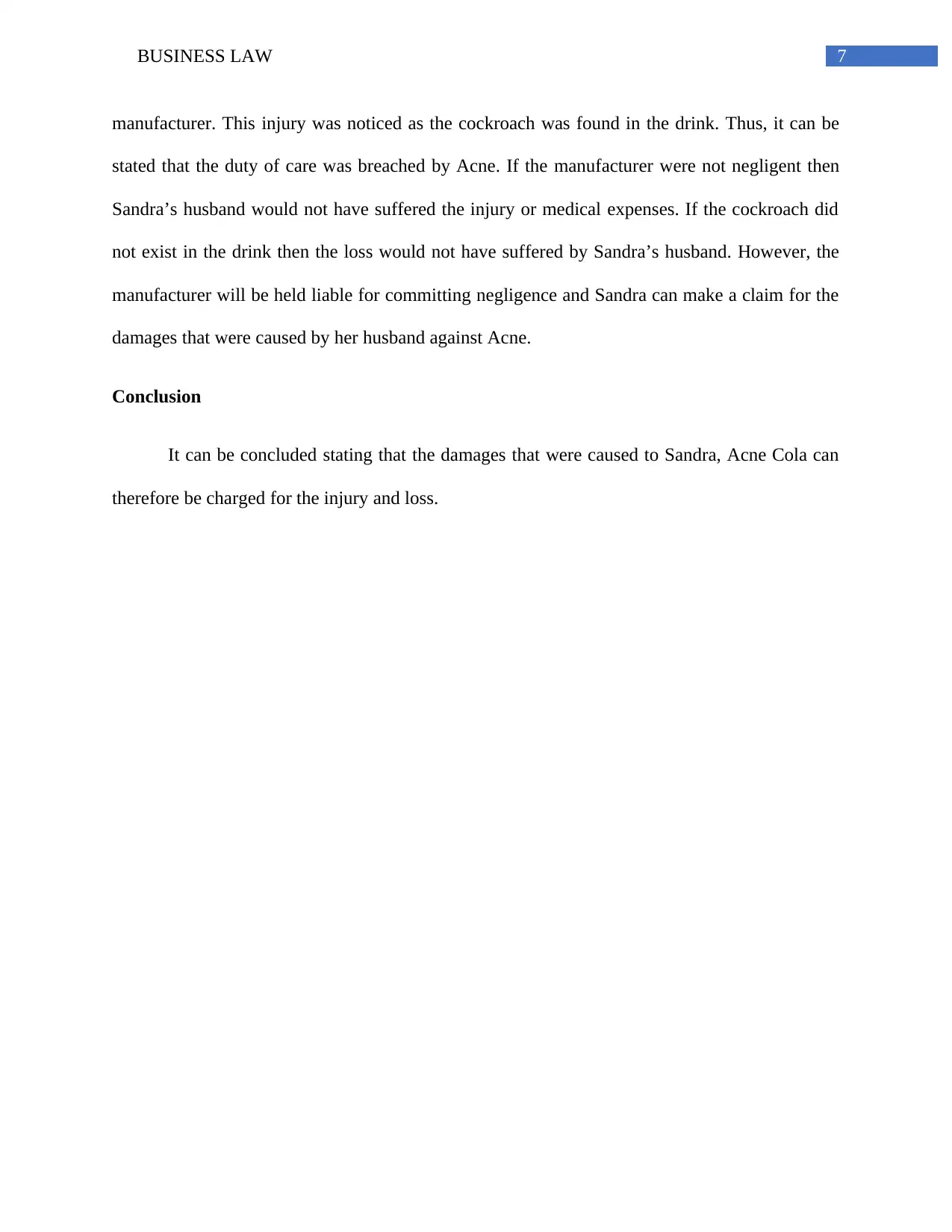
7BUSINESS LAW
manufacturer. This injury was noticed as the cockroach was found in the drink. Thus, it can be
stated that the duty of care was breached by Acne. If the manufacturer were not negligent then
Sandra’s husband would not have suffered the injury or medical expenses. If the cockroach did
not exist in the drink then the loss would not have suffered by Sandra’s husband. However, the
manufacturer will be held liable for committing negligence and Sandra can make a claim for the
damages that were caused by her husband against Acne.
Conclusion
It can be concluded stating that the damages that were caused to Sandra, Acne Cola can
therefore be charged for the injury and loss.
manufacturer. This injury was noticed as the cockroach was found in the drink. Thus, it can be
stated that the duty of care was breached by Acne. If the manufacturer were not negligent then
Sandra’s husband would not have suffered the injury or medical expenses. If the cockroach did
not exist in the drink then the loss would not have suffered by Sandra’s husband. However, the
manufacturer will be held liable for committing negligence and Sandra can make a claim for the
damages that were caused by her husband against Acne.
Conclusion
It can be concluded stating that the damages that were caused to Sandra, Acne Cola can
therefore be charged for the injury and loss.
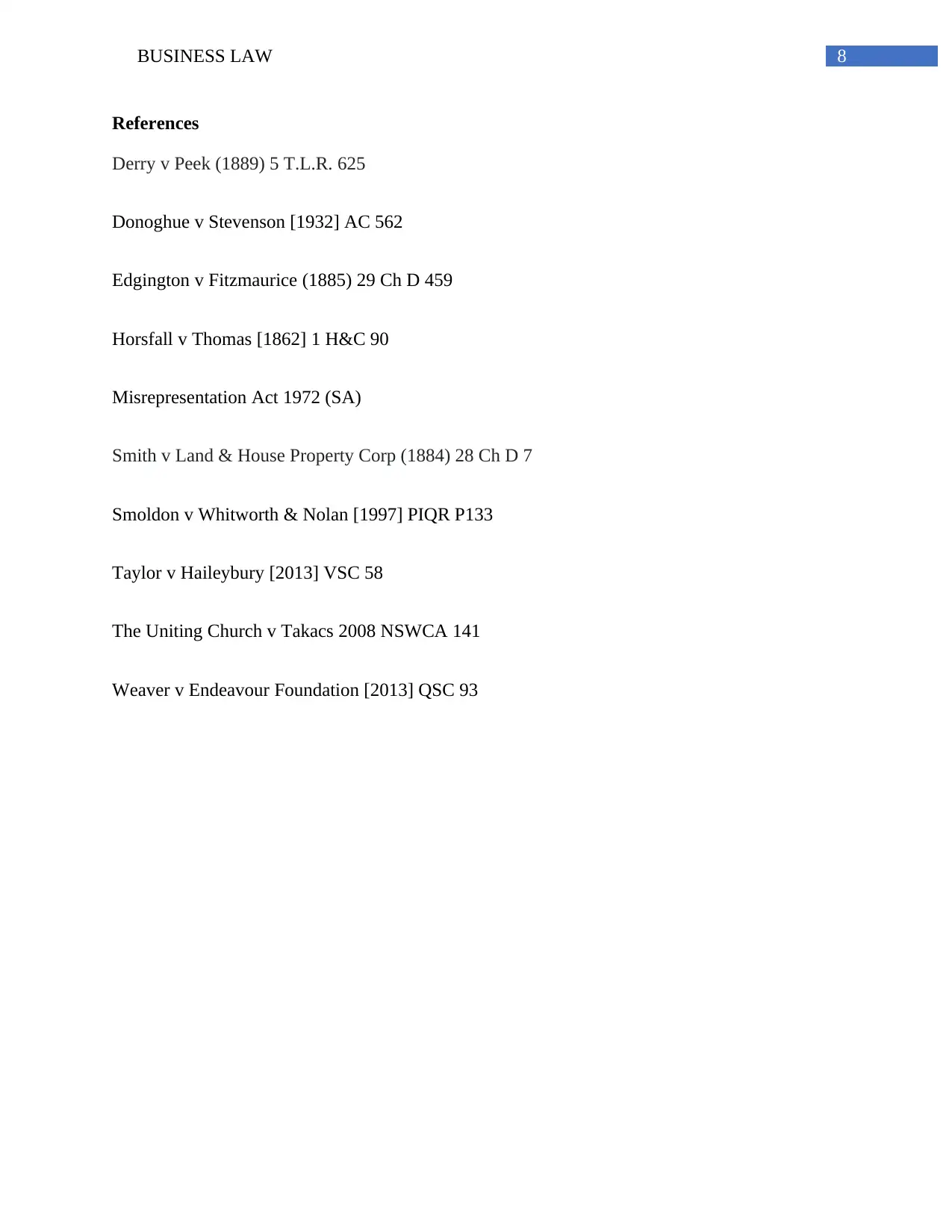
8BUSINESS LAW
References
Derry v Peek (1889) 5 T.L.R. 625
Donoghue v Stevenson [1932] AC 562
Edgington v Fitzmaurice (1885) 29 Ch D 459
Horsfall v Thomas [1862] 1 H&C 90
Misrepresentation Act 1972 (SA)
Smith v Land & House Property Corp (1884) 28 Ch D 7
Smoldon v Whitworth & Nolan [1997] PIQR P133
Taylor v Haileybury [2013] VSC 58
The Uniting Church v Takacs 2008 NSWCA 141
Weaver v Endeavour Foundation [2013] QSC 93
References
Derry v Peek (1889) 5 T.L.R. 625
Donoghue v Stevenson [1932] AC 562
Edgington v Fitzmaurice (1885) 29 Ch D 459
Horsfall v Thomas [1862] 1 H&C 90
Misrepresentation Act 1972 (SA)
Smith v Land & House Property Corp (1884) 28 Ch D 7
Smoldon v Whitworth & Nolan [1997] PIQR P133
Taylor v Haileybury [2013] VSC 58
The Uniting Church v Takacs 2008 NSWCA 141
Weaver v Endeavour Foundation [2013] QSC 93
⊘ This is a preview!⊘
Do you want full access?
Subscribe today to unlock all pages.

Trusted by 1+ million students worldwide
1 out of 9
Related Documents
Your All-in-One AI-Powered Toolkit for Academic Success.
+13062052269
info@desklib.com
Available 24*7 on WhatsApp / Email
![[object Object]](/_next/static/media/star-bottom.7253800d.svg)
Unlock your academic potential
Copyright © 2020–2025 A2Z Services. All Rights Reserved. Developed and managed by ZUCOL.





